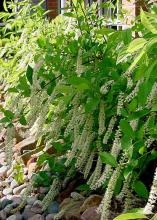Information Possibly Outdated
The information presented on this page was originally released on May 13, 2002. It may not be outdated, but please search our site for more current information. If you plan to quote or reference this information in a publication, please check with the Extension specialist or author before proceeding.
Virginia sweetspires show off everywhere
By Norman Winter
MSU Horticulturist
Central Mississippi Research & Extension Center
The past couple of weeks have been awesome at our office thanks to a group of native plants that has everyone inquiring about them. They are Virginia sweetspires, and we have them growing along a natural-looking creek bed lined with rocks.
Although they are named Virginia, they also are native to Mississippi and have to be among the best of the overlooked natives. You may know them as Virginia willows instead of Virginia sweetspires, but you will love them by either name. Selections like Sarah's Eve and Henry's Garnet, which we have at our office, may be available at your local garden center.
Virginia willow is known botanically as Itea virginica. "Itea" is Greek for willow. Although it is not a willow, its graceful habit and sweetly fragrant flowers will make it a natural for woodland gardens and paths.
As this upright grower reaches its peak height between 5 and 8 feet, the branches bend over in an elegant, graceful habit. The flowers on superior blooming cultivars like Henry's Garnet are white and 4 to 6 inches long with a sweet fragrance. They usually bloom in April and May. The long, white flower spikes brighten up shady areas as clumps produce hundreds of blooms that all visitors in the vicinity notice.
You could ask where does "garnet" fit into the name. Virginia willows have handsome, dark-green foliage until fall when it turns into striking shades of reddish-purple and burgundy.
Henry's Garnet is not only superior in bloom, but the fall foliage is exceptional with its long-lasting, garnet-red color. In fact, fall colors may persist all winter in South Mississippi, while in colder zones, it will most certainly last until December.
The gorgeous, clump-forming shrub has other excellent virtues. It is disease and insect resistant. It thrives in moist, heavy soils, yet has proven to thrive in heat and droughty conditions. It is considered evergreen with temperatures as low as 15 to 20 degrees and deciduous in colder climates. It has recovered from temperatures as cold as minus 20 degrees.
Virginia sweetspires form additional clumps by spreading underground stems. It is not hard to keep it in bounds or maintained. Pruning will help you develop the desired arching, mounding shrub look rather than a thicket or briar appearance.
The ideal location is in a natural area where the plants receive morning sun and afternoon shade. They combine beautifully with azaleas from the Satsuki group that bloom about the same time.
If you choose a shadier location, the growth habit will be more open and sparse while in a full sun site, it will be bushier and require more water. The best time to fertilize is in late winter. Use a cup of a slow-release, 13-13-13 spread evenly under mature plants.
Henry's Garnet was chosen as a Louisiana Select winner and would easily qualify throughout the South. If your favorite garden center does not have them yet, they should have no problem locating a source. Henry's Garnet and other Virginia willows transplant easily from container-grown nursery stock.
There are native plants that deserve a place in your landscape, and this is one of the best.



